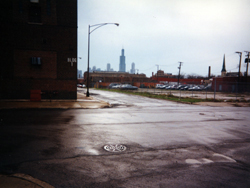
Chicago Corner
Bill Brown - 2010, 4:50, DV, Madison, WI
I lived around the corner from the Henry Horner Homes. I once read an article about the place in the New York Times. The title of the article was "What It's Like To Live In Hell." By the time I moved to Chicago, the Horner Homes were empty. The city began to knock down the buildings, one by one, till there was only one building left. It stood there for years. Then the city knocked it down, too.
Bill Brown lives in Madison, Wisconsin, where it is often winter.
Interview
ATA: Throughout the film, overlapping images (sometimes taken from the same vantage point) evoke the layers of a painting, and give a felt sense of the passage of time. For how long did you take pictures of the site?
BB: I was working in downtown Chicago, so every day for year, I'd ride my bike past that corner near the Henry Horner projects. Then i'd stop and snap a picture with a disposable 35mm camera. Do they still make those? The good thing about a cardboard camera is you can throw it in your backpack and not worry if it gets crushed by books or beer bottles. You can forget you even have it, then you ride past something worth taking a picture of, and you remember you have a camera buried somewhere in your bag.
ATA: For those of us who may not know about Westhaven Park (formerly Henry Haven Homes), can you describe a little bit of its history?
BB: The Henry Horner homes were built in the late 1950's on the near West Side of Chicago. The Lake Street elevated train rolls right by them, but it doesn't stop. You'd think they would have built a train stop at a place that used to house thousands of people, but they didn't. The projects consisted of something like 19 buildings, highrises and lowrises. Whatever utopian visions that inspired the first wave of public housing in the 1930's had definitely vanished by the late-50's. By then, public housing was pretty much just warehousing for poor people. By the 1980's, the gangs had taken over. I found a 1987 NY Times article about the Horner Homes. It was titled "What It's Like to Live in Hell."
ATA: Could you share with us some of your favorite writers, filmmakers, artists, or other individuals who inspire you?
BB: I like the New Topographics photographers a lot: Lewis Baltz, the Bechers, Frank Gohlke. I really love Camilo Jose Vergara's photos, too. All those images of shattered cities and recycled buildings. I like essay filmmakers, too. Chris Marker. Greta Snider.
ATA: What should I have asked you?
BB: "You moved away from SF to live in Wisconsin? What the hell were you thinking?"
Interview by Liz Wing of ATA


